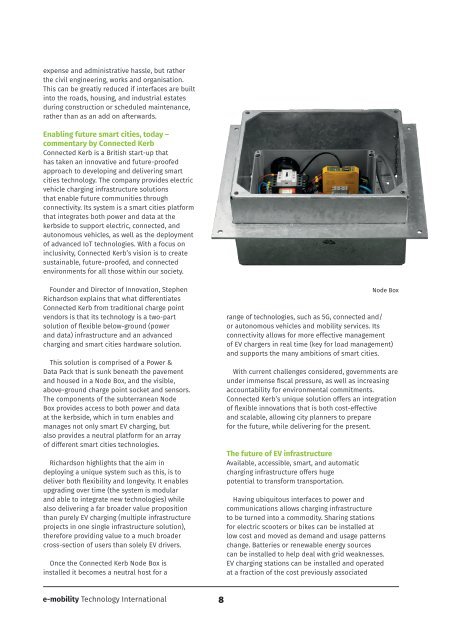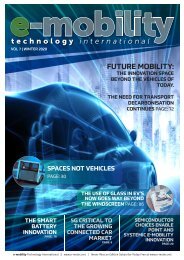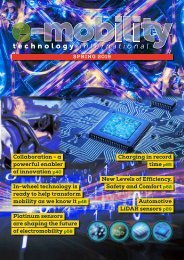E-mobility Technology Summer 2020
Engage with the innovators who are making the shift to electric vehicles a reality
Engage with the innovators who are making the shift to electric vehicles a reality
Create successful ePaper yourself
Turn your PDF publications into a flip-book with our unique Google optimized e-Paper software.
expense and administrative hassle, but rather<br />
the civil engineering, works and organisation.<br />
This can be greatly reduced if interfaces are built<br />
into the roads, housing, and industrial estates<br />
during construction or scheduled maintenance,<br />
rather than as an add on afterwards.<br />
Enabling future smart cities, today –<br />
commentary by Connected Kerb<br />
Connected Kerb is a British start-up that<br />
has taken an innovative and future-proofed<br />
approach to developing and delivering smart<br />
cities technology. The company provides electric<br />
vehicle charging infrastructure solutions<br />
that enable future communities through<br />
connectivity. Its system is a smart cities platform<br />
that integrates both power and data at the<br />
kerbside to support electric, connected, and<br />
autonomous vehicles, as well as the deployment<br />
of advanced IoT technologies. With a focus on<br />
inclusivity, Connected Kerb’s vision is to create<br />
sustainable, future-proofed, and connected<br />
environments for all those within our society.<br />
Founder and Director of Innovation, Stephen<br />
Richardson explains that what differentiates<br />
Connected Kerb from traditional charge point<br />
vendors is that its technology is a two-part<br />
solution of flexible below-ground (power<br />
and data) infrastructure and an advanced<br />
charging and smart cities hardware solution.<br />
This solution is comprised of a Power &<br />
Data Pack that is sunk beneath the pavement<br />
and housed in a Node Box, and the visible,<br />
above-ground charge point socket and sensors.<br />
The components of the subterranean Node<br />
Box provides access to both power and data<br />
at the kerbside, which in turn enables and<br />
manages not only smart EV charging, but<br />
also provides a neutral platform for an array<br />
of different smart cities technologies.<br />
Richardson highlights that the aim in<br />
deploying a unique system such as this, is to<br />
deliver both flexibility and longevity. It enables<br />
upgrading over time (the system is modular<br />
and able to integrate new technologies) while<br />
also delivering a far broader value proposition<br />
than purely EV charging (multiple infrastructure<br />
projects in one single infrastructure solution),<br />
therefore providing value to a much broader<br />
cross-section of users than solely EV drivers.<br />
Once the Connected Kerb Node Box is<br />
installed it becomes a neutral host for a<br />
range of technologies, such as 5G, connected and/<br />
or autonomous vehicles and <strong>mobility</strong> services. Its<br />
connectivity allows for more effective management<br />
of EV chargers in real time (key for load management)<br />
and supports the many ambitions of smart cities.<br />
With current challenges considered, governments are<br />
under immense fiscal pressure, as well as increasing<br />
accountability for environmental commitments.<br />
Connected Kerb’s unique solution offers an integration<br />
of flexible innovations that is both cost-effective<br />
and scalable, allowing city planners to prepare<br />
for the future, while delivering for the present.<br />
The future of EV infrastructure<br />
Available, accessible, smart, and automatic<br />
charging infrastructure offers huge<br />
potential to transform transportation.<br />
Node Box<br />
Having ubiquitous interfaces to power and<br />
communications allows charging infrastructure<br />
to be turned into a commodity. Sharing stations<br />
for electric scooters or bikes can be installed at<br />
low cost and moved as demand and usage patterns<br />
change. Batteries or renewable energy sources<br />
can be installed to help deal with grid weaknesses.<br />
EV charging stations can be installed and operated<br />
at a fraction of the cost previously associated<br />
with these technologies.<br />
Smart charging and fleet management allows<br />
electric vehicles to have a higher up-time while<br />
also reducing wear and tear. Battery state of<br />
charge can be maintained at optimum levels,<br />
avoiding complete discharge or charge cycles<br />
which stress battery technology, meaning<br />
batteries last longer. Historic usage patterns<br />
and even weather data can be utilised. For<br />
example, if there is a week of rain and cold<br />
weather ahead, it is likely that shared scooters<br />
will not be used, so the state of charge can be<br />
set to conservation levels. However, if a long<br />
weekend ahead promises perfect weather,<br />
the scooters can be charged up to full to<br />
prepare for the expected surge in demand.<br />
Inductive charging with its automatic handsfree<br />
process, no wear and tear and ability to<br />
be seamlessly integrated into the landscape<br />
provides the final piece to the puzzle.<br />
At INTIS, we envisage a future infrastructure<br />
which is seamless, invisible, and automatic. A<br />
customer picks up an electric scooter from a<br />
charging station integrated into the pavement.<br />
The vehicle assigned to them has the correct<br />
state of charge to complete their trip and<br />
INTIS easy charge 5 inductive station for Metz moover electric scooters<br />
was chosen because its battery has experienced<br />
a lower number of charging cycles than other<br />
available options. The customer makes their way to<br />
their destination; already, a charging slot has been<br />
reserved for the vehicle and another trip has been<br />
lined up after a planned 20 minutes of charging<br />
to top up the battery. The customer reaches their<br />
destination and parks the scooter at another charging<br />
station in front of the train station, at which point<br />
the opportunity charging process is immediately and<br />
automatically started. At no point has the customer<br />
or the operator had to think about the energy<br />
needed to travel; the whole process is effortless.<br />
Infrastructure like this not only enhances the<br />
experience for the user, it reduces costs for the<br />
operator as well, both by reducing maintenance<br />
and increasing the longevity of the vehicle. Looking<br />
to the future of electric vehicles, this kind of<br />
infrastructure also allows battery capacity to be<br />
reduced, further saving both money and resources.<br />
Throughout the history of technology, each<br />
progressive step has involved greater use of<br />
resources and energy. The results of this are<br />
clear to everyone. Electric vehicles powered by<br />
renewable energy generation and enabled by<br />
smart infrastructure have the potential to buck this<br />
trend, providing truly sustainable <strong>mobility</strong>. •<br />
e-<strong>mobility</strong> <strong>Technology</strong> International 8 9<br />
<strong>Summer</strong> <strong>2020</strong>









